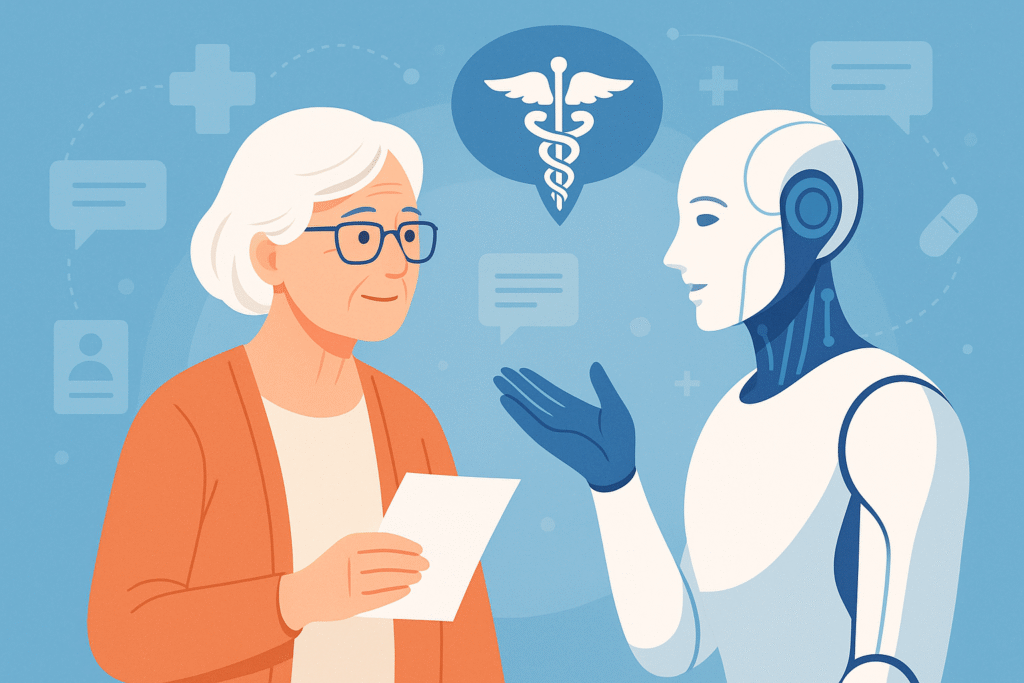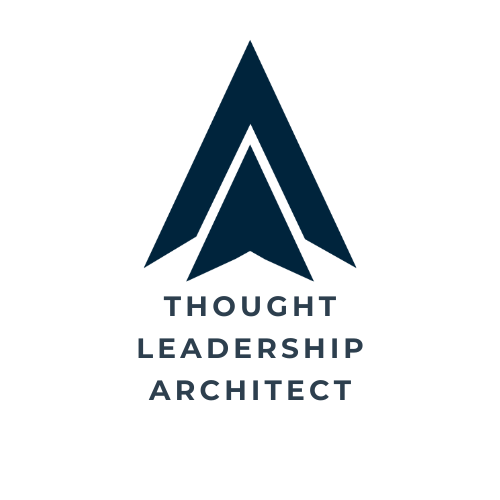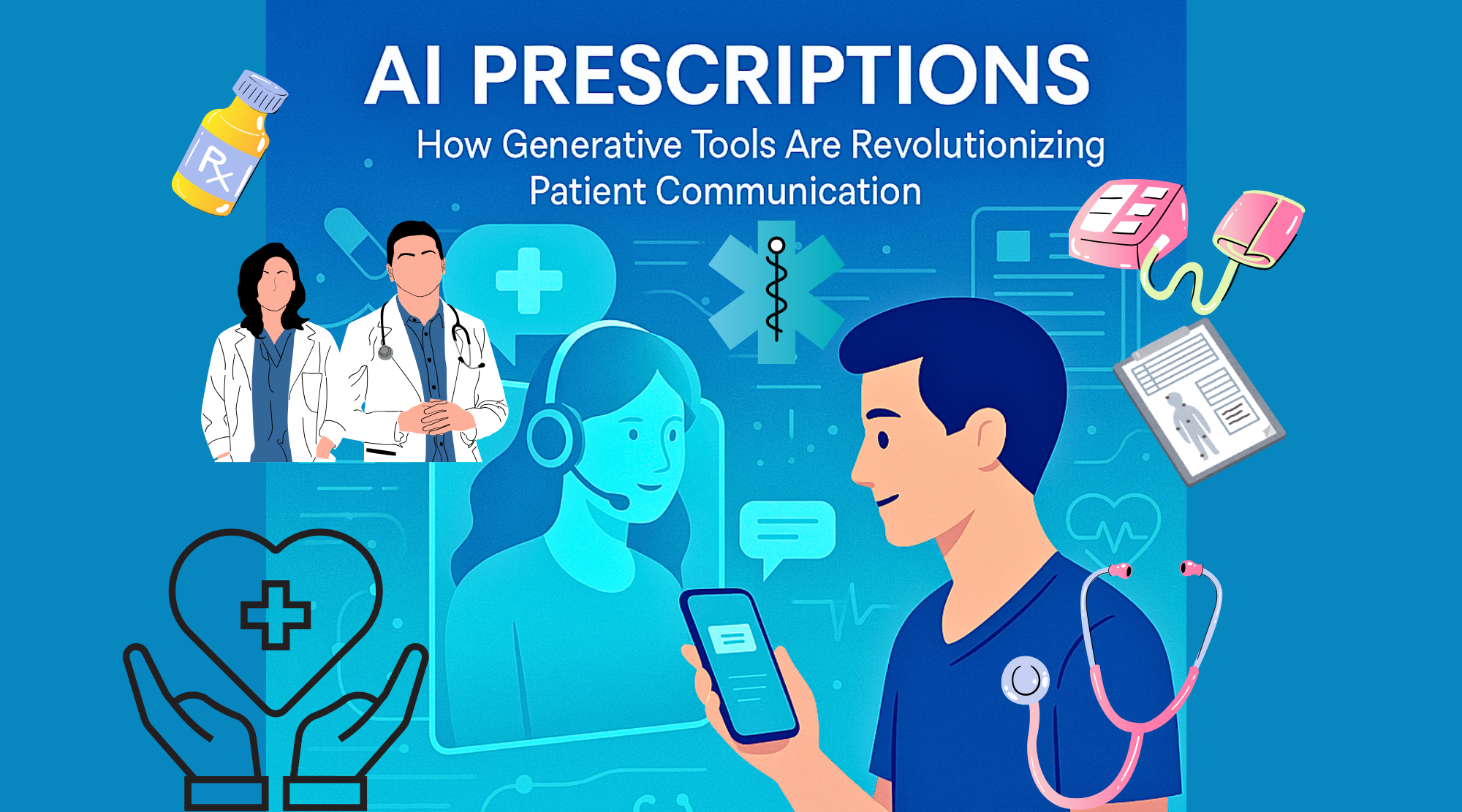Your cart is currently empty!
In a world increasingly shaped by artificial intelligence, the next revolution in healthcare isn’t just happening in the lab or operating room—it’s unfolding in the inbox, on the screen, and even in the voice on the phone. From appointment reminders to medication guidance and chronic care education, generative AI tools are transforming patient communication at scale.
As trust, clarity, and timely information become vital to patient outcomes, hospitals and healthcare providers are discovering a powerful ally in custom GPTs and large language models (LLMs). In 2025, AI doesn’t just diagnose. It explains, reminds, reassures—and helps patients stay healthier, longer.
What Are Generative Tools in Healthcare?
Generative AI refers to systems that can generate text, speech, images, or other data based on training models. In the healthcare communication space, this includes:
- Chatbots that explain post-operative care instructions
- Personalized appointment reminders written in natural language
- Educational summaries of test results
- Tailored medication compliance messages
- Multi-language support for diverse patient populations
“Generative AI is not replacing doctors—it’s replacing silence,” says Dr. Nina Foster, Director of Digital Health Innovation at MedBridge Clinics. “It fills the dangerous gaps between visits, where confusion and noncompliance often grow.”
Why Traditional Patient Communication Falls Short
- Overload of clinical jargon: Even printed discharge instructions can be difficult to interpret.
- One-size-fits-all language: Generic templates don’t reflect individual circumstances.
- Limited staffing for follow-up: Nurses and assistants are overwhelmed.
- Language barriers: Multilingual needs are underserved in many health systems.
- Lack of real-time support: Patients often wait days for simple answers.
These gaps contribute to nonadherence, readmission, and poor satisfaction scores—costing U.S. health systems over $300 billion annually.¹

The GPT Transformation: Custom AI for Each Practice
Today’s custom GPTs (Generative Pretrained Transformers) can be trained on an individual clinic’s guidelines, tone, and patient FAQs, creating an AI assistant that speaks your brand of care.
Examples:
- A pediatric practice may use an AI tool that translates medical advice into reassuring messages for parents.
- A diabetes clinic’s GPT can text patients with friendly, AI-generated nudges about insulin timing, hydration, and foot checks.
- A telehealth provider may deploy a multilingual AI receptionist that books appointments and answers coverage questions instantly.
“We’ve seen patients become more engaged when communications feel human, timely, and personalized—three things AI now delivers at scale,” says Elena Rivas, VP of Patient Experience at BrightPath Health.
Outcomes: The Measurable Benefits of AI-Led Patient Communication
Health systems using generative AI for patient outreach report:
- 21% higher medication adherence
- 17% fewer missed appointments
- 30% increase in patient portal engagement
- Improved patient satisfaction and trust scores
More importantly, health equity improves when AI tools are used to reduce language barriers, support underserved communities, and deliver culturally relevant content.
According to a 2025 report from the National Institutes of Health, “Generative AI, when deployed with transparency and equity in mind, has the potential to reduce communication disparities at scale.”²
Compliance and Safety: Can AI Be HIPAA-Safe?
Yes—but only when built thoughtfully.
Key Considerations:
- Use on-premise or encrypted API solutions to avoid data leaks.
- Train GPTs using de-identified, institution-approved data.
- Include human-in-the-loop checkpoints for high-risk content.
- Log and audit all communications for accountability.
“It’s possible to create compliant AI tools that align with HIPAA and GDPR by design,” says Tomoko Ishida, AI Ethics Lead at MedCloud Systems. “Don’t bolt on privacy—build it in.”
Real-World Tools: Examples from the Field
🔹 HealthBot+
Used by clinics to deliver AI-generated follow-ups that adapt to patient responses in real time. Example: “Hey Maria, I saw your last blood sugar was high. Don’t forget your eye check is coming up!”
🔹 CareGPT for Seniors
Trained on common senior health conditions, this GPT explains complex treatments with voice-to-text, large-font output, and simplified vocabulary.
🔹 PharmaCom AI
Used by pharmaceutical companies to send customized patient onboarding instructions for new prescriptions—including side effects, interactions, and insurance coverage info.
Use Case: The AI Assistant Who Never Sleeps
Starlight Women’s Health in Denver implemented a custom GPT to handle:
- Appointment confirmations and reschedules
- Insurance questions
- FAQs about birth control, pregnancy, and screenings
- Automated birthday messages with care tips
Over six months, they saw:
- A 24% drop in phone call volume
- A 38% increase in portal signups
- “Overwhelmingly positive patient feedback” on communication tone
“Our AI assistant speaks like we do—kind, helpful, and informed,” said their Practice Director. “It’s like having another front-desk team that never sleeps.”
Best Practices for Thoughtful Deployment
- Define your voice and tone
Is your practice friendly and casual or formal and precise? Train the AI accordingly. - Start with FAQs and reminders
Build confidence by automating low-risk, high-volume messages first. - Include cultural and linguistic context
Serve Spanish-speaking patients? Add translation layers trained in medical nuance. - Get feedback early
Let patients “rate” AI messages and fine-tune based on sentiment. - Ensure human override
Patients should always have a path to a real clinician when needed.
The Future of AI in Patient Communication
Looking ahead, we can expect:
- Voice-activated AI health coaches for daily wellness
- Predictive engagement: AI nudging patients before they lapse
- Emotion-aware communication: LLMs that sense frustration or confusion
- Integration with wearables to offer real-time, tailored advice
“In five years, patient communication will be so intelligent and intuitive, people won’t know whether they’re talking to AI or a human—and they won’t mind,” predicts Dr. Samuel Qi, Chief Futurist at GenHealth AI.
Why Thought Leaders Must Embrace This Now
AI-generated patient engagement is not a tech gimmick—it’s a strategic communication capability.
✔ Builds trust
✔ Enhances health outcomes
✔ Lowers costs
✔ Improves access and equity
Organizations that ignore these tools risk falling behind on both performance and perception.
At Thought Leadership Architect™, we help healthcare leaders deploy AI with confidence, compliance, and compassion—so they can lead with clarity in an AI-driven world.
Key Takeaways
- Generative AI tools (like GPTs) are revolutionizing how healthcare organizations communicate with patients.
- Benefits include higher adherence, reduced staff burden, and better outcomes.
- Custom GPTs tailored to your practice’s tone and protocols offer the best results.
- HIPAA-compliant, multilingual, and accessible communication is now achievable at scale.
- The future of healthcare will be built on trusted, AI-driven conversations.
Bibliography
- Centers for Medicare & Medicaid Services. Annual Report on Preventable Readmissions. (2024)
- NIH Office of Equity. Generative AI and Health Communication Equity: A 2025 Review.
- Dr. Nina Foster Interview. Digital Health Now Podcast, March 2025.
- BrightPath Health Case Study. Transforming Engagement with Generative AI. (2025)
- GenHealth AI. AI Trends in Patient-Centered Communication. (2024)
#GenerativeAI #HealthcareInnovation #PatientCommunication #AIinMedicine #DigitalHealth #CustomGPT #HealthEquity #HIPAACompliance #ThoughtLeadership #AIOutreach



Leave a Reply